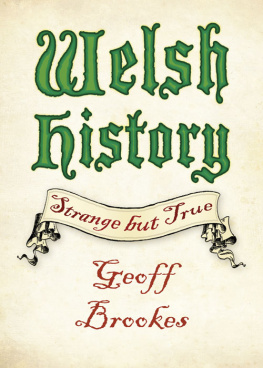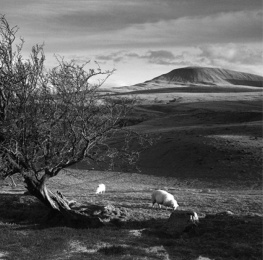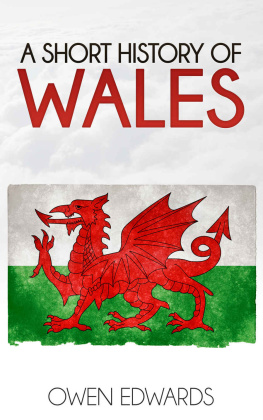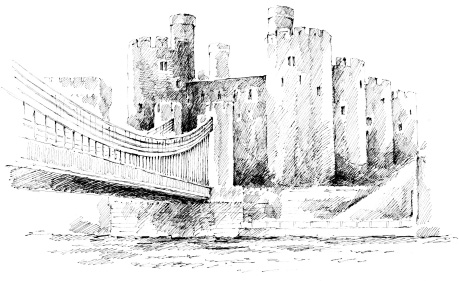Contents
About the Book
Take a spellbinding journey around Wales to discover the tales buried deep in the countrys history.
Packed full of legends, firsts, birthplaces, inventions and adventures, I Never Knew That About Wales unearths the hidden gems all thirteen traditional Welsh counties hold. Explore Britains greatest collection of castles, wander the glorious Gower peninsula, Britains first Area of Outstanding Natural Beauty, or marvel at Pontcysyllte, the longest bridged aqueduct in Britain.
This irresistible compendium will give you a captivating insight into the people, ideas and events that have shaped the individual identity of every place you visit, and will have you exclaiming again and again: Well, I never knew that!
About the Author
Christopher Winn has been a freelance writer and trivia collector for over twenty years. He has worked with Terry Wogan and Jonathan Ross, and sets quiz questions for television as well as for the Daily Mail and Daily Express. He also produces for theatre and recently toured with Hugh Massingberds play, Ancestral Voices, about James Lees-Milne. He is author of the bestselling I Never Knew That About England (Ebury Press, 2004). Books in the same series now cover Ireland, Scotland and London.
Conwy Castle, Caernarfonshire
For Esther
Preface
Wales may be small in size but her influence is mighty. She is an ancient civilisation with Europes oldest language and earliest seats of learning. Her collection of castles is the finest in the world and speaks of a rich and turbulent history. Wales gave us Britains greatest Royal dynasty, the Tudors. A Welshman gave his name to America, Richard ap Meryk, who became Sheriff of Bristol and sponsored the Cabot brothers in their voyages of discovery to the New World.
Wales is the Land of Song and Poetry and brings the peoples of the world together in friendly competition. Her music soars around the globe and her musicians and actors mesmerise and win awards with their passion and their range.
Wales was the worlds first industrial nation. Her coal and iron and back-breaking toil drove the Industrial Revolution and built the modern world. Her people fought for social justice, for dignity and for fairness.
The beauties of Wales, her wild mountains and moorlands, lacustrine valleys and glorious coastlines, inspired the Picturesque movement, the first landscape painters, and the first Area of Outstanding Natural Beauty.
For all this, Wales does not strut or boast or preen, but quietly nurtures her plentiful treasures behind mountains or in deep valleys. She is full of surprises, constantly delighting the traveller with the unexpected, one moment vast, magnificent panoramas, stately cathedrals and castles and giant monuments of industry, then tiny, exquisite chapels, ancient burial grounds, cottages, waterfalls, green woods and dales.
In Wales there is nowhere that is not wondrous, nowhere that fails to amaze and charm, nowhere that does not bring forth the exclamation I never knew that!
Wales is like nowhere else.
The Counties of Wales
I have organised I Never Knew That About Wales into the 13 traditional counties that existed from medieval times until the lamentable local government reorganisation in 1974.
Glamorgan and Pembrokeshire have both been distinctive areas from ancient days, while Anglesey, Caernarfonshire, Cardiganshire, Carmarthenshire, Flintshire and Merioneth were created by the Statute of Rhuddlan in 1284. The other 5 counties of Denbighshire, Montgomeryshire, Radnorshire, Breconshire and Monmouthshire were established out of the Marcher fiefdoms by the Law in Wales Act of 1535, which abolished the powers of the Lordships of the Marches.
While the post-1974 county names reflect some of the old Welsh kingdoms, their physical boundaries do not always equate to those of the original territories, which were, in any case, somewhat fluid. Nor do the modern counties take account of old loyalties and identities. The traditional counties, on the other hand, were quite deliberately determined by the ancient divisions of the country, are the most settled and long lasting of all the divisions of Wales, and form the backdrop, in terms of both time and flavour, to most of the stories in this book.
A NGLESEY
(YNYS MON)
C OUNTY T OWN: B EAUMARIS
St Tysilios Chapel and the Menai Bridge, the worlds first large-scale suspension bridge
Menai Strait
Bridging the Divide
FOR AS LONG as anyone can remember, the island of Anglesey has been separated from the mainland by its own very effective moat, the M ENAI S TRAIT , 12 miles (19 km) of surging tides, treacherous sandbanks and whirling currents, 600 ft (180 m) across at its narrowest point. Today, according to the European Union, Anglesey no longer qualifies as an island, thanks to the success of two unique bridges.
Menai Bridge
The M ENAI B RIDGE , designed by Thomas Telford and opened on 30 January 1826, was THE FIRST SUSPENSION BRIDGE IN THE WORLD CONSTRUCTED TO TAKE HEAVY TRAFFIC . At the time it was built it was THE LONGEST BRIDGE IN THE WORLD , 1,265 ft (386 m) in length, with a main span of 579 ft (176 m) hung from wrought-iron chains and suspended 100 ft (30 m) above the high tide mark, allowing plenty of room for ships to pass underneath. In 1839, the deck of the bridge was damaged by strong gales, and it has been replaced twice, once in 1893, and most recently in 1940 with a steel deck.
As well as being an engineering wonder, the Menai Bridge is utterly beautiful. When seen from the A4080 viewing point to the west, it looks like an integral part of the landscape, the graceful lines of the bridge blending seamlessly with the undulating shapes of the Snowdonia mountains behind.
On the Anglesey side, on a little promontory below the bridge, there is a reminder of the times when it was not so easy to reach the island. A small 14th-century church sits on the site of a chapel founded in AD 630 by St Tysilio, where travellers could rest and pray, or give thanks, for a safe crossing.
















